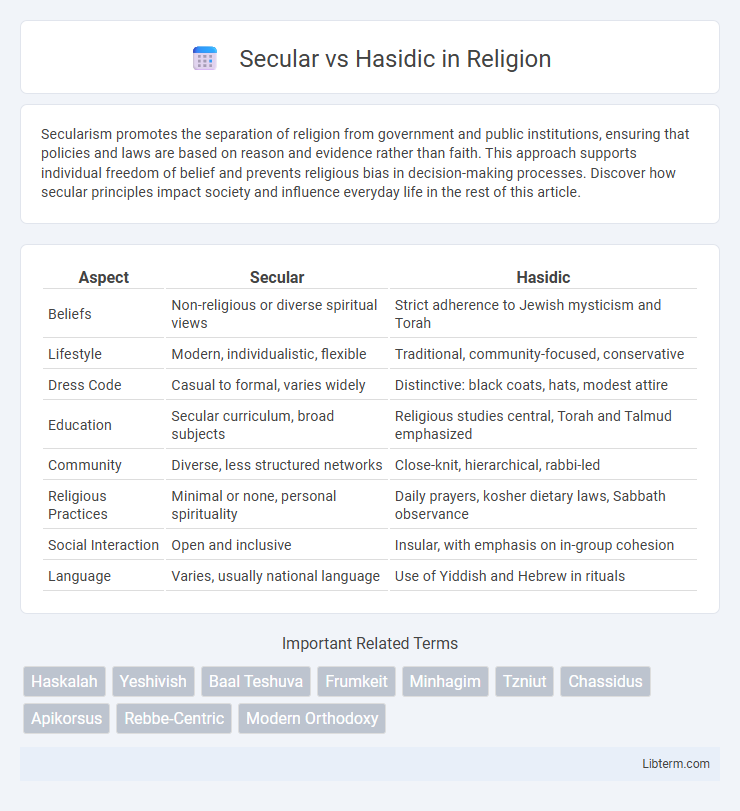Secularism promotes the separation of religion from government and public institutions, ensuring that policies and laws are based on reason and evidence rather than faith. This approach supports individual freedom of belief and prevents religious bias in decision-making processes. Discover how secular principles impact society and influence everyday life in the rest of this article.
Table of Comparison
| Aspect | Secular | Hasidic |
|---|---|---|
| Beliefs | Non-religious or diverse spiritual views | Strict adherence to Jewish mysticism and Torah |
| Lifestyle | Modern, individualistic, flexible | Traditional, community-focused, conservative |
| Dress Code | Casual to formal, varies widely | Distinctive: black coats, hats, modest attire |
| Education | Secular curriculum, broad subjects | Religious studies central, Torah and Talmud emphasized |
| Community | Diverse, less structured networks | Close-knit, hierarchical, rabbi-led |
| Religious Practices | Minimal or none, personal spirituality | Daily prayers, kosher dietary laws, Sabbath observance |
| Social Interaction | Open and inclusive | Insular, with emphasis on in-group cohesion |
| Language | Varies, usually national language | Use of Yiddish and Hebrew in rituals |
Introduction to Secular and Hasidic Lifestyles
Secular lifestyles prioritize modernity, individualism, and participation in contemporary culture, often emphasizing education, technology, and personal freedom. Hasidic lifestyles, rooted in Orthodox Judaism, center on religious observance, community cohesion, and adherence to traditional customs and teachings. The contrast between these lifestyles highlights differing values regarding spirituality, social norms, and daily practices.
Historical Roots of Secular and Hasidic Judaism
Secular Judaism emerged primarily in the 19th and 20th centuries as part of the Jewish Enlightenment, emphasizing cultural identity and rationalism while distancing from traditional religious observance. Hasidic Judaism traces its roots to the 18th century Polish and Ukrainian regions, founded by Rabbi Israel Baal Shem Tov, focusing on mysticism, piety, and communal spirituality. The historical divergence highlights Secular Judaism's adaptation to modernity and Hasidic Judaism's preservation of spiritual devotion and traditional customs.
Core Beliefs and Philosophies
Secular Judaism emphasizes cultural identity and ethical values without strict adherence to religious laws, focusing on modernity, reason, and individual autonomy. Hasidic Judaism centers on mysticism, piety, and community, highlighting the importance of fervent prayer, adherence to halacha (Jewish law), and the guidance of a Rebbe as a spiritual leader. Core Hasidic philosophy involves connecting deeply with God through joy and faith, contrasting with secular views that prioritize rationalism and secular ethics.
Daily Life: Rituals and Practices
Secular Jewish daily life typically emphasizes cultural traditions, ethical values, and personal spirituality without strict adherence to religious rituals, allowing flexibility in practices like kosher dietary laws and Sabbath observance. Hasidic communities strictly observe Jewish law (Halacha) with daily rituals including prayer three times a day, wearing traditional garments such as the shtreimel and bekishe, and maintaining stringent kosher and Sabbath rules. These practices shape distinct lifestyles where Hasidic life centers on communal worship and rabbinical guidance, while secular Jews often integrate modern secular norms with selective religious customs.
Education Systems: Secular vs Hasidic Approaches
Secular education systems emphasize a broad, government-regulated curriculum that includes science, mathematics, literature, and social studies, promoting critical thinking and diverse worldviews. Hasidic education prioritizes religious studies with extensive focus on Torah, Talmud, and Yiddish language, often limiting secular subjects to facilitate spiritual growth and community values. This divergence in educational approach impacts literacy in secular disciplines and integration into broader society, influencing personal and economic opportunities.
Dress Codes and Cultural Symbols
Secular Jewish individuals typically adopt contemporary Western clothing free from religious markers, while Hasidic Jews adhere strictly to traditional dress codes such as black frocks, white shirts, and fur hats known as shtreimels, symbolizing piety and community identity. Beards and sidelocks (payot) are prominent cultural symbols within Hasidic communities, reflecting adherence to Torah commandments and distinct religious customs. The contrast in dress and symbols underscores differing levels of religious observance and cultural preservation between secular and Hasidic Jews.
Social Structure and Community Roles
Secular Jewish communities typically emphasize individual autonomy with flexible social roles shaped by personal choice and modern societal norms. In contrast, Hasidic communities maintain a hierarchical social structure centered around religious leadership, such as the Rebbe, who guides spiritual and communal life. Social roles in Hasidic groups are often defined by gender and religious obligations, fostering tightly knit, insular networks with strong communal support systems.
Attitudes Toward Modernity and Technology
Secular Jews typically embrace modernity and technological advancements as integral to daily life and progress, prioritizing innovation and digital connectivity. Hasidic communities maintain a cautious approach, often limiting exposure to technology to preserve religious values and communal cohesion, with many restricting internet use and smartphone access. This contrast highlights the broader tension between secular integration and traditional religious preservation within differing Jewish cultural contexts.
Challenges and Controversies in Coexistence
The coexistence of secular and Hasidic communities in shared urban areas often sparks challenges related to differing lifestyle norms, religious practices, and educational priorities, leading to tensions over public space usage, gender roles, and community governance. Controversies arise around issues such as housing density, zoning laws, and allocation of public funds, exacerbated by contrasting views on secular versus religious education and participation in civic life. Navigating these conflicts requires nuanced dialogue and legal frameworks that respect religious freedoms while addressing the rights and needs of the secular population.
Future Trends and Changing Dynamics
The future trends in the relationship between secular and Hasidic communities indicate increasing interaction due to demographic growth and urban expansion, driving shifts in social and cultural dynamics. Technology adoption in Hasidic groups is gradually rising, influencing education and communication, while secular communities experience growing awareness of Hasidic traditions. Policy changes and community dialogues aim to bridge gaps, fostering coexistence amid evolving identities and mutual influence.
Secular Infographic

 libterm.com
libterm.com